What Is Link Building? The Beginners Guide to Link Building for SEO
Sep 20, 2024
Written by Casey Bjorkdahl

Casey Bjorkdahl is one of the pioneering thought leaders in the SEO community. In 2010, Casey co-founded Vazoola after working for a Digital Marketing Agency for five years in New York City. Vazoola is now one of the fastest growing and most widely recognized SEO marketing firms in the country.
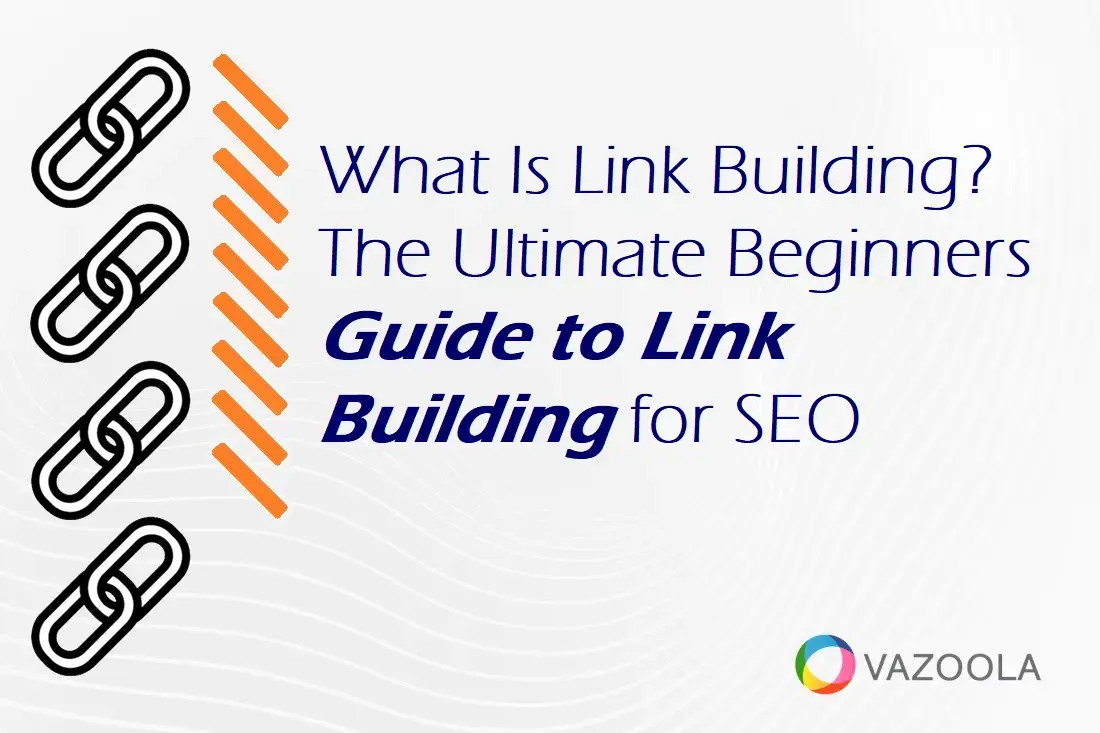
As an SEO agency, link building is at the core of what we do. We also believe in sharing what we know, so you can decide whether you want to do your own link building or work with an agency like Vazoola to help manage your SEO. This comprehensive guide is a summary of many years of work in link building. We’ve taken our most commonly asked questions to create this Ultimate Beginner’s Guide to Link Building for SEO.
Key Takeaways:
-
-
Link building is the group of strategy and tactics used for attracting and acquiring hyperlinks from other websites to yours, for the purpose of improving search engine optimization and visibility.
-
2023 research into SEO Ranking Factors shows link building is still one of the top factors in SEO success.
-
Even exceptional content can only attract links organically if it can be found online.
-
Build links only from quality sites and relevant content. Improve visibility by using internal links.
-
A natural link profile contains 70% branded, 20% naked, 5% generic, 1-5% Latent Semantic Indexing (LSI) or partial match or titles and less than 1% exact match anchor text.
-
Our favorite link building strategies include Guest Posting, Niche Edits, and creating Link Worthy Content.
-
Not all websites are in the best position to benefit from link building. Perform technical optimization on your site before starting link building efforts.
-
Table of Contents
Why Link Building is Important?
What is the Best Link Building Approach?
Our Top Link Building Strategies
17 Key Things to Know About Link Building
What is Link Building (Our Definition)?
Link building in SEO is the group of strategies and tactics used for attracting and acquiring hyperlinks from other websites to yours, for the purpose of improving search engine optimization and visibility.
Creating links, especially high quality links, will bring you more traffic and increase your income! We've been building backlinks for over 14 years for thousands of SEO agencies, brands, and small businesses.
Because of this, we routinely see how high quality backlinks to key pages help websites reach more of their target audience.
You want to avoid spammy link building techniques, right? But not all links are quality links. We provide everything you need to know about popular link building strategies below.
How Does Link Building Work?
Link building is an off page SEO strategy. There are three ways to build links:
-
Build links yourself
-
Earn links
-
Buy links

Backlinks are votes in the search engine and are foundational to the algorithm deciding what sites deserve to rank highest in the search results (SERPs).
The key to success is quality, relevancy, and natural placements. SEO metrics are used to evaluate link quality and determine the value of your incoming links.
Hyperlinks are links that are clickable and take you to another web page or location on the same page. They are also referred to as "live links".
Why Does a Link Building Strategy Matter?
Link building techniques are important because relevant quality SEO links determine search engine rankings. And you need high ranking pages to generate traffic, leads, conversions and income. To put it simply, links directly impact business success.
Google and other search engines use incoming links to judge site and brand authority. Without links, your site is unlikely to get found online. It's therefore a highly worthwhile effort to invest in link building strategies.
Is link building still relevant?
While Google may claim that links are not as important as they once were, ranking factor publications put out by experts in search engine optimization (SEO) who do testing show they are still critical.
Some, like David Farkas, say link building is the #1 factor in getting a site to rank. In new research for 2023, First Page Sage shows links tied for second.
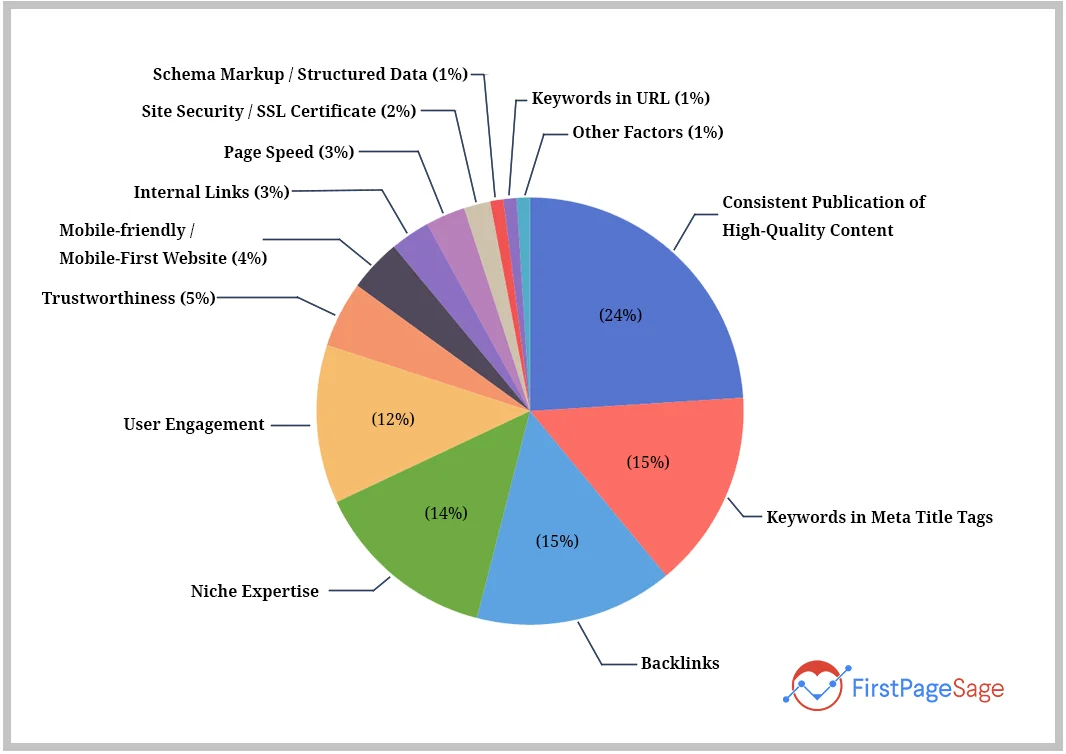
First Page Sage is the largest SEO company in the U.S. That gives them a substantial database from which they drew the conclusions that led to their 2023 SEO Ranking Factors study.

Whether quality backlinks are #1 or #2, they are clearly still critical to your success. You need a strong link building strategy if you hope to improve your rankings and maximize your organic traffic, rankings and revenue.
Read on for comprehensive information on how to do link building.
What is the Best Link Building Approach?
A variety of options are available as link-building tactics and strategies, ranging from earning natural links with high-quality content to actively seeking backlinks through outreach and partnerships.
Each method presents its own unique benefits and challenges, and the best approach depends on your specific goals, resources, and industry.
Setting a clear link-building strategy from the outset is crucial, as it guides your efforts and makes sure your link-building activities align with your overall SEO objectives.
A link building strategy might include steps like:
-
SEO Audit: Start with a comprehensive technical SEO audit to identify and fix any issues that could hinder your link-building efforts.
-
Keyword Research: Next, conduct thorough keyword research to understand what terms your target audience is searching for.
-
Optimize: Optimize your on-page SEO, ensuring that your content is valuable, engaging, and aligned with the keywords you want to rank for.
Given the complexity and nuances of effective link building, consulting a professional can be highly beneficial. SEO experts can help you identify the best tactics for your specific situation, whether it's leveraging content marketing, engaging in strategic outreach, or employing other methods.
SEO professionals can also make sure your link-building strategy is ethical and sustainable, avoiding black hat tactics that could harm your site. By considering your resources and bandwidth, a professional can help you develop and execute a plan that moves your link-building efforts forward effectively.
Our Top Link Building Strategies
Our favorite three strategies for link building are Niche Edits, Guest Posts, and creating Link Worthy Content!
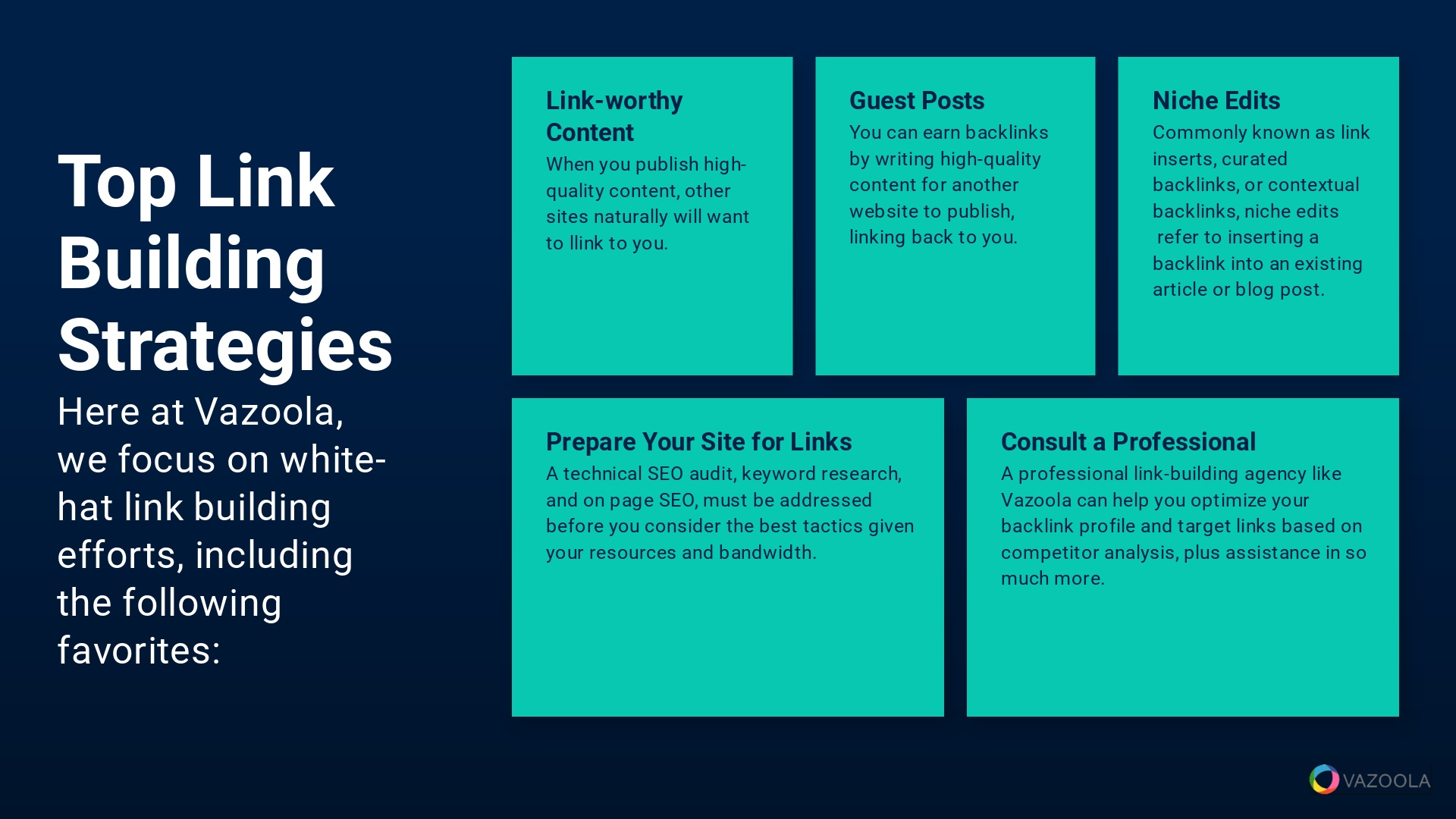
Link Worthy Content
The easiest links you'll ever build are the ones you don't have to acquire manually. Check out our section on link worthy content as an SEO strategy below for ways to attract links organically!
Niche Edits (Link Inserts)
Niche Edits are also commonly known as link inserts, curated backlinks, or contextual backlinks. This refers to inserting a backlink into an existing article or blog post.
Guest Posts
A guest post (or guest blog) is a piece of content that is created by one party and published on another party's website.
This SEO link building guide covers these and more!
17 Key Things to Know About Link Building
As you learn how to do link building for SEO properly, this backlink guide will explain the basics. Why should you consider doing link building? Because search traffic converts best, and you need SEO linking to maximize that traffic.
1. Do Keyword Research First
Knowing what keyword phrases are most valuable to your site and business is the first step. It guides what content you create, publish, and promote and what high quality links you want to acquire.
SEOs use many premium link building tools. But the free Ubersuggest keyword research tool is sufficient to get started. It pulls data from Google, which only those who have high AdWords spends can access directly now.
Start with the general words that describe what you offer. Then follow the tips on how to use Ubersuggest here.
Narrow your keyword phrases down to those that are highly relevant. Decide by asking yourself whether someone searching for that phrase would be specifically looking for what you offer.
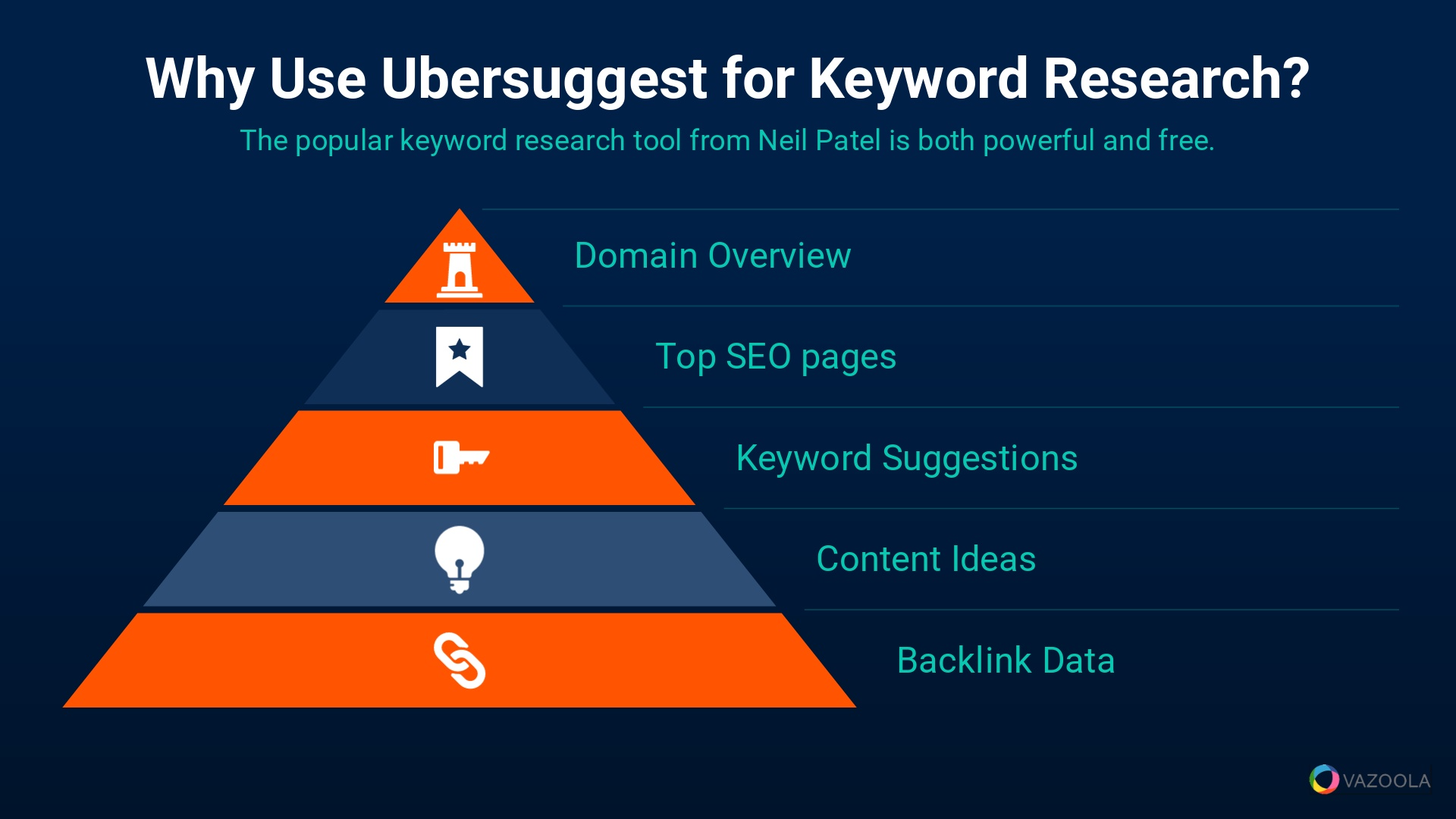
1.1 Organizing Your Link Building Keyword Research
Keyword research can be exported into spreadsheets. While many SEOs exclusively use spreadsheets, you may prefer a more visual method.
The free project management tool Trello is ideal for prioritizing your keywords. You can learn to use it in ten minutes. See this Trello 101 to get started.
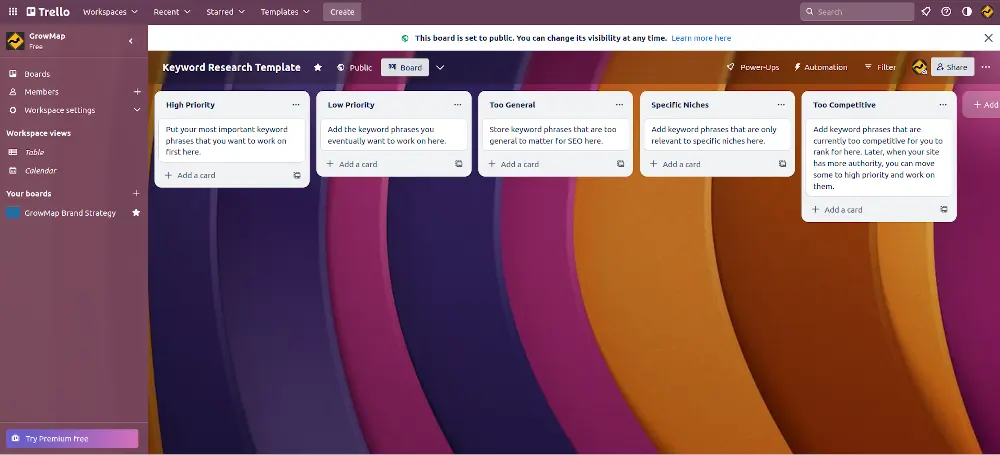
Make a copy of this free Keyword Research Trello board we created. It contains columns for:
-
High priority
-
Low priority
-
Too general
-
Specific niches
-
Too competitive
Then create a card for each keyword phrase showing the keyword, search volume, CPC, and competition value on the front of the card.
Easily sort cards by priority. Create one piece of pillar content for each keyword phrase and add the URL of that content to the card.
Then start building backlinks to that content. Use a separate Trello board to track site owners you contact, content you submit and published links.
2. Consider Backlink Quality
Before you start your link building work, get familiar with how to judge the quality of a backlink to determine if it will add value to your backlink profile, or not. The basic requirements for successful placements are:
-
Authority
-
Relevance
-
Traffic
If the backlinks pointing to your site don't meet the basic requirements, they're not likely to be providing much value for your rankings.
Various companies provide metrics to assist in site evaluation. See our Link Building Tools content for details.
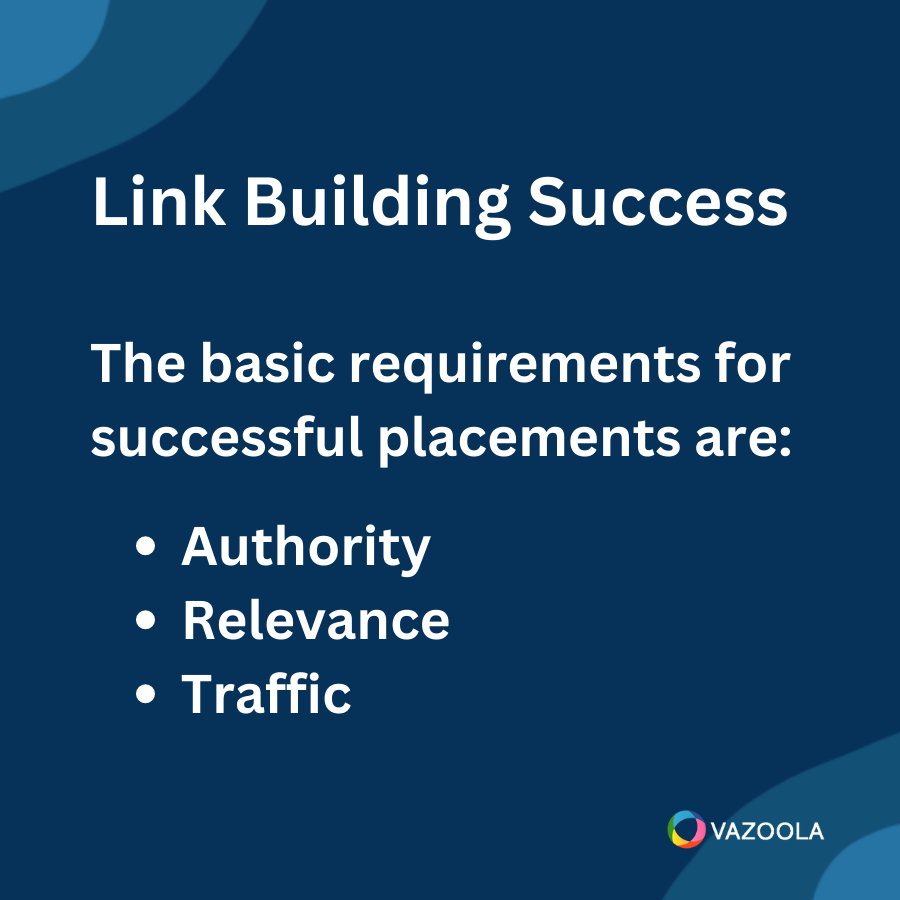
Google states that they score pages on a per URL basis, not over a full domain.
2.1 Relevance is Extremely Important
A pervasive mistake in link building campaigns is to not put enough emphasis on relevance. An incoming link from a highly related site is much more valuable than a link from a higher value but less related site.
Focus on getting links pointing from many very relevant sites in your niche. Have links point from content specifically about your keyword phrase from a quality site in your niche.
A link from a relevant site is worth more than a link from any unrelated site.That does not mean other links may not be valuable. Only that the most relevant links should be your target.
If the site you want does not have any relevant content already, offer to write a guest post for them.
2.2 Authority
Ahrefs, Moz, SEMrush and Majestic calculations and metrics are used by SEOs in place of Google PR to evaluate sites today.

Domain Authority is a measurement that estimates the authoritativeness of your site and predicts its ability to rank against other sites, but is not a direct ranking factor. There are many measures of a domain’s authoritativeness available from several companies, but backlinks are at the foundation of the algorithm for all of them. The higher the quality of your backlink profile, the higher your domain authority is likely to be.

When building links, be sure to consider the domain authority of links you are considering getting backlinks from. Given that domain authority is a comparative metric, a domain authority of 50+ is generally considered strong, but a "good" domain authority is a function of your competitors scores.
2.3 Traffic
A hallmark of a high quality backlink is organic traffic. If the website you are considering getting a backlink from has organic traffic it means that at least some of its pages are performing well in the search engines which indicates that the site ranks well for some keywords and is favored by Google.
Alternatively, many low quality links come from sites that do not get any traffic and can often be spammy, part of a Public Blog Network (PBN), or a link farm - a site that exists solely for the purpose of selling links.
In a study of more than 1 billion web pages, Ahrefs found only a tiny fraction - just 1.25% - receives more than 100 organic visits each month, as pictured below.
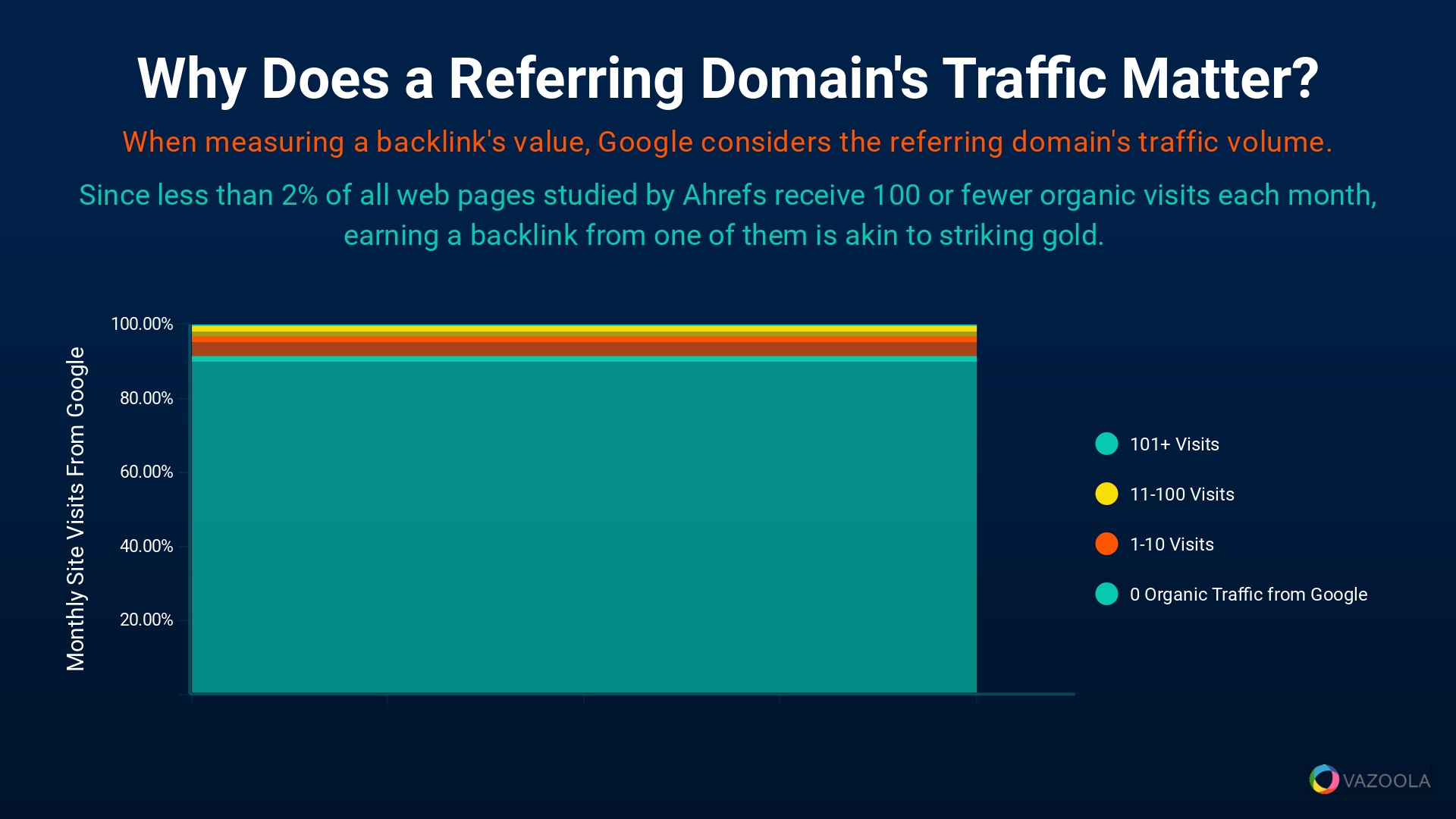
2.4 Type of Placement
The way a backlink is placed can affect the “juice” it passes on to your site. We recommend placing link naturally. This means in high quality content that is relevant to your website. Also, the anchor text used should make sense and fall in line with a natural anchor text strategy.
3. Types of Links
People use a variety of different types of linking pages. It is useful to know the standard terminology so that you can make inquiries accurately and follow the latest research. Here are some common types defined:
-
Homepage link: a link that goes to the primary domain URL
-
Branded link: company name used as anchor text, typically linked to the home page
-
Editorial link: editorial content linked to a comprehensive blog post or other informative, long-form content
-
URL link: a link to any domain with any top level domain (TLD)
-
Image alt tag
-
Brand + keyword
-
Title: a link whose anchor text is the title of content on your site
-
Naked link: any variation of anchor text using a URL including those starting with http, https, www, or just domain.com. (Examples: www.domain.com, http://domain.com, http://yourdomain.com, https://domain.com, or https://www.domain.com)
-
Internal links: Linked pages within the same site. Ensure your priority pages link to each other.
In a separate post, we list 40 types of good and bad backlinks.
While some SEOs insist that it is essential to include naked links while doing linkbuilding 101, most writers consider them unnatural and almost never use them.
Google hints that naked links are not necessary in this article. Publishers and writers would probably prefer you leave them out of content you request.

3.1 What Are Nofollow Links?
When commenting in blogs became commonplace, Google introduced the practice of adding code to a link to make it “no follow”.
This term is not accurate because robots do appear to follow these links. We know that because they get indexed in the search results.
“No juice” might be more accurate. In theory, links that have the nofollow link attribute do not pass Google PageRank (PR).
Officially, nofollow links have no link SEO value. Search Engine Journal concluded:
Nofollow links are not a Google ranking factor. Their function is to tell major search engines not to add additional weight or ranking.
Nofollow links are an improper way of blocking web crawlers from finding a webpage because Google may decide to crawl and index Nofollow links, but that’s all.
Whether or not the anchor text of Nofollow links holds any weight can not be confirmed and is still open for debate.
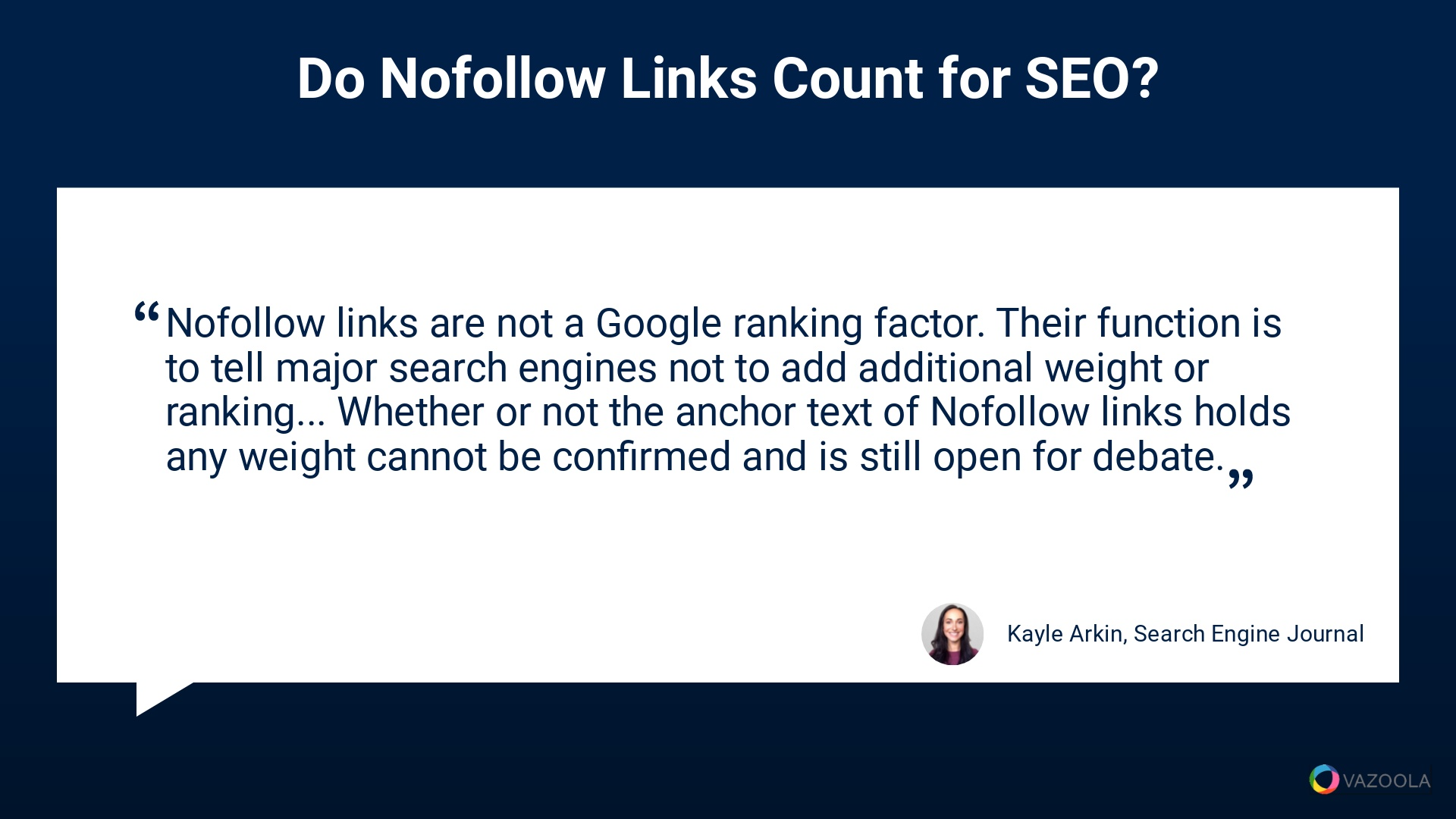
However, some SEOs argue that they do have value. This case study shows links from a relevant linking page directly caused their site's linked page to rank #1.
And in Should You Waste Time and Money on Nofollow Links? Here’s a Final Answer, Neil Patel makes a strong case that nofollow links do have SEO value.
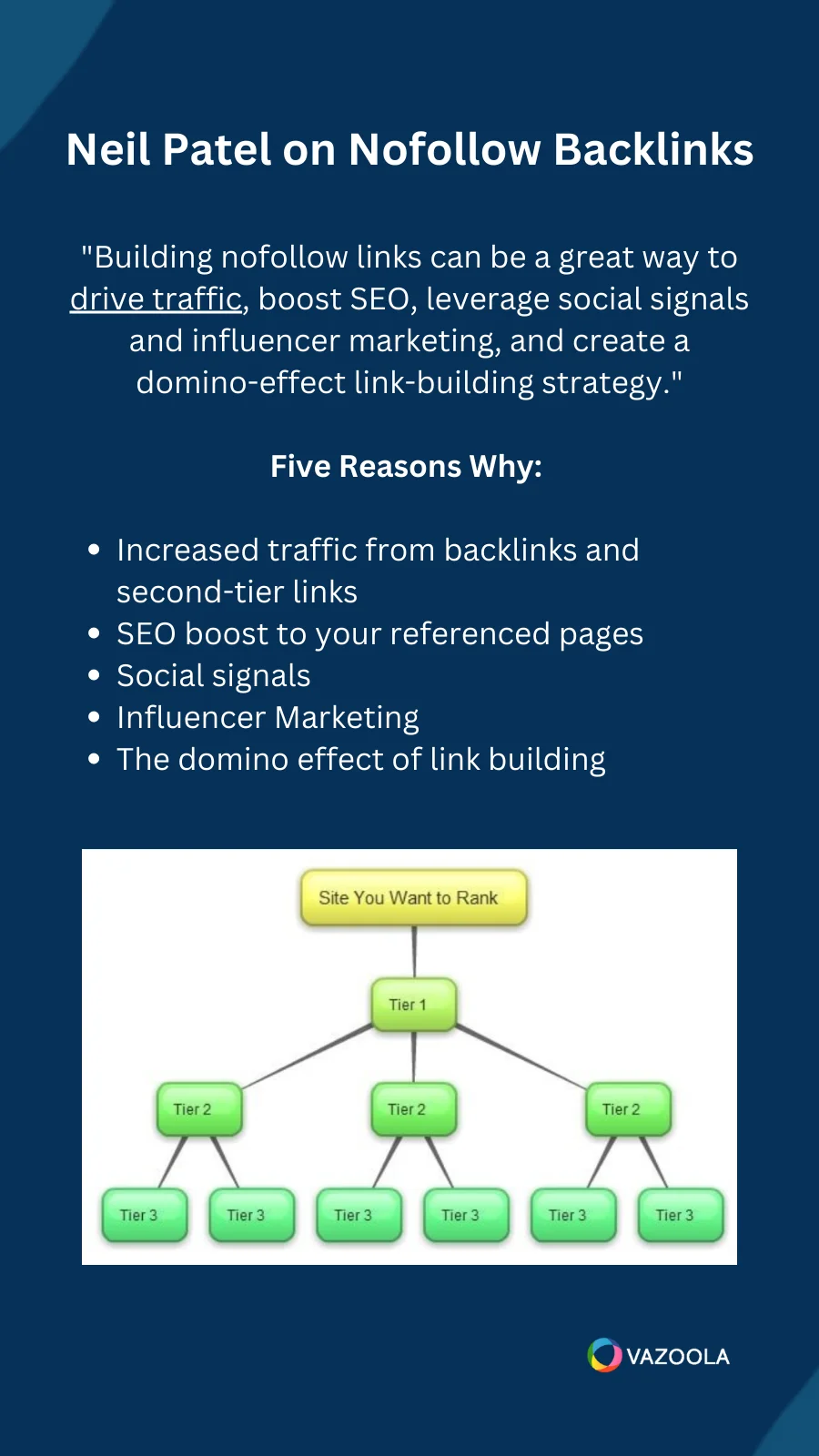
3.2 Additional Link Attributes Added to Nofollow:
Besides the nofollow attribute, link builders now have to be aware of two additional related attributes: sponsored (spon) and user generate content (UGC).
For full details, read Google's Evolving Nofollow guidelines.
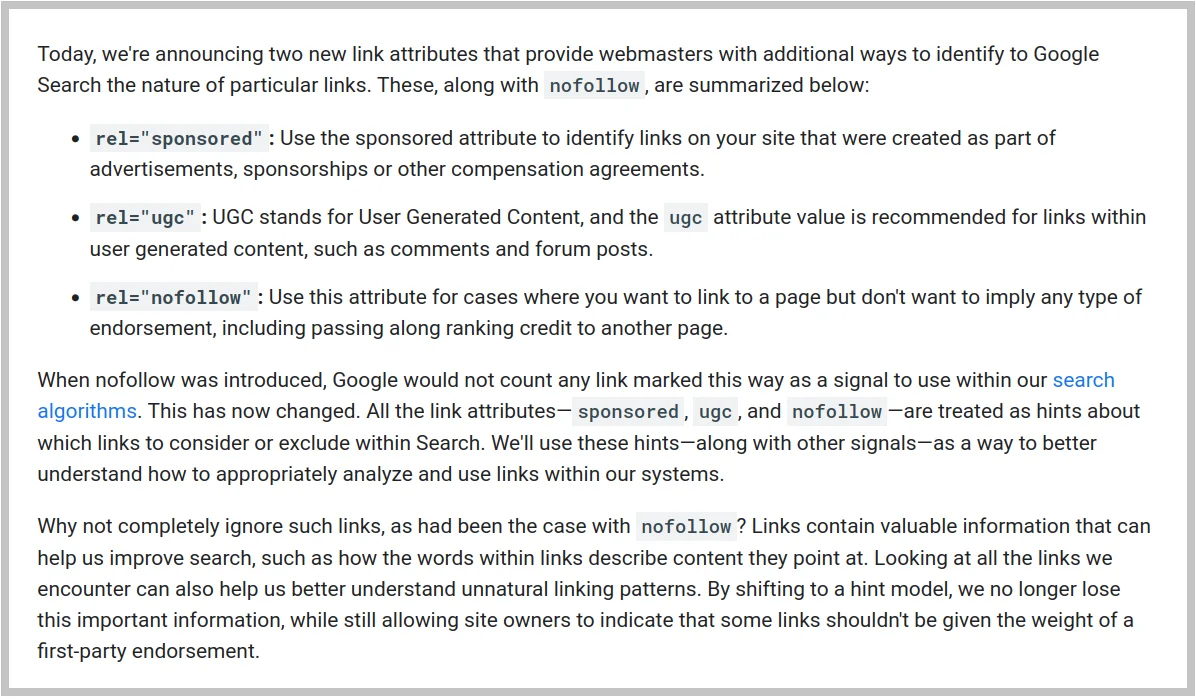
3.3 What Are DoFollow Links?
Until Google introduced nofollow links, there was no such thing as a “do follow” link. Unless a link has a nofollow attribute added to the HTML, it is naturally a dofollow link.
Dofollow links are considered more valuable for SEO rankings because they pass “link juice”.
We have a separate guide that explains the difference between nofollow and dofollow links.
4. What is Anchor Text?
The words that make up the part of the text that contains the actual link you click on to visit another web page are the anchor text.
Example: In this sentence, click here (typically highlighted in blue and often underlined) is the anchor. If you want to start a huge debate, argue whether you should use “click here” to encourage clicks or not use “click here” because it has no direct value for ranking purposes.

4.1 Exact Match
An exact match link includes only the specific targeted keyword phrase. For example, if your target phrase were “link building” the anchor text would be link building.
Exact match text is not as necessary today as it once was because of semantic search. Read Semantic Search Explained in 5 Minutes to understand what it is.
4.2 Partial Match
Partial match would contain only some of your keyword phrase with or without additional words.
Here are some examples for a partial match of the phrase “link building” in the following sentence: “Read this to learn link building safely.”

See how we created partial match phrases for “learn link” and “building safely” in the example above?
4.3 Latent Semantic Index Keywords (LSI)
Neil Patel uses Latent Semantic Index Keywords (LSI) even though he acknowledges that some feel they are ineffective. It can’t hurt if not overdone.
4.4 How Anchors Evolved Over Time
Each site owner or writer online tends to link in different ways. At one time, writers would choose the phrase that best describes the page where each link lands.
But due to pressure from Google, SEO link builders today will often intentionally avoid using that type of keyword phrase.
On prominent sites, you will often see text that says “research shows” or “according to” some source rather than text indicating what type of research or what the source discussed.
4.5 Be Careful With Exact Match
There was a time when it was common practice to use exact match. So if you wanted to rank for “link building” you would get others to link to you using the phrase “link building”.
If you do that too much today, Google’s core algorithm is likely to lower the ranking of your site. Cautious SEOs now only build one exact match link per phrase.
Others with premium tools will build based on the percentage of other types of links. A natural link profile has varying ratios of types of anchors.
4.6 The Importance of Co-Occurrence
By including additional words from your target keyword phrase close to your link, you can increase the value of links without the risk of using too much exact match.
Here’s an example. If the brand name Vazoola often appears near the words “link building company”, Google will assume that our site is relevant for search results about link building even though the brand name was not linked.
4.7 Understanding Co-Citations
Some SEOs theorize that if a third site mentions two sites as being correlated with each other, Google will recognize a relation between those two sites.
According to this post on Search Engine Journal, co-citations can be an important ranking factor.
5. What is a Natural Link Profile?
Building external links is not without risk. It is critical to do your backlink building profile naturally. You want your link profile to appear organic.
Avoid focusing only on exact match phrases unless you have done extensive research and know the percentages by type of links from other websites pointing at your site.
The safest method is to build one link per exact match phrase. Be sure to have a mix of all other link types such as partial match, branded, editorial, URL, and naked.
5.1 Average Percentages of Types of Links
There is no consensus on exact percentages. Some SEOs treat this information as valuable proprietary and confidential data.
Others have shared their advice publicly. Note how low the exact match percentages are. How many links of each type are too many depends on your niche.
5.2 Gotch SEO Anchor Text Percentages
In Gotch SEO’s Anchor Text updated for 2023, Nathan Gotch recommended:
-
70% branded
-
20% naked
-
5% generic
-
1-5% LSI or partial match or titles
-
Exact match less than 1%
In an interview, he said that the naked link percentages will usually come from business listings, press releases, profile links, etc. and not contextual placements.
And the reason he recommends such a high percentage of branded links is to keep people out of trouble getting too many anchor text links.
5.3 Serpstat Anchor Text Percentages
-
Branded: 50%
-
Naked links: 20%
-
Generic: 5%
-
LSI, partial match: 1-5%
-
Exact match: less than or equal to 1%.
As you can see, their recommendations are very similar to what others in the website link building SEO community recommend.
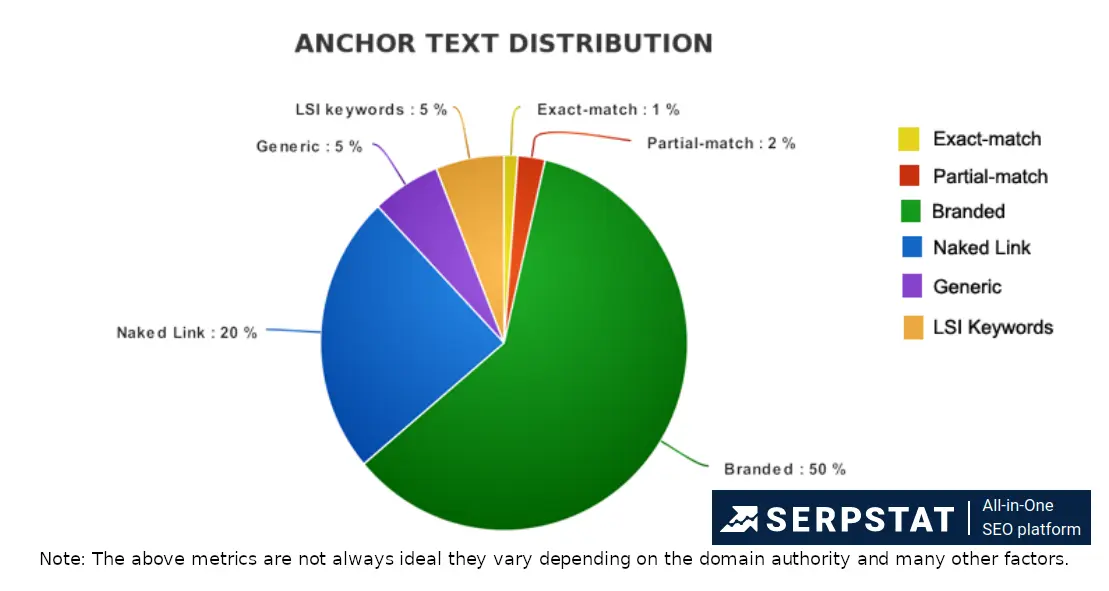
6. Featured Snippets
What is better than ranking #1 for a search phrase? Having your site at the top of the page in a Featured Snippet on Google can be even better. (Some are calling this position 0.)

Optimizing for Featured Snippets can be a substantial competitive advantage. The first step is to build enough quality links to rank within the top 10 listings.

We cover how to find and steal featured snippets both manually and using featured snippet tools in our Guide to Choosing a Link Building Tool.
7. Link Building Campaign Mistakes to Avoid
While building an effective backlink profile is essential for improving your website's search engine ranking, it's equally important to avoid common mistakes that can harm your efforts.
Missteps in link building can lead to penalties or reduced effectiveness of your SEO strategies. Stay with us as we explore some frequent link-building errors and how to steer clear of them.
7.1 Unnatural Link Profile
Many people end up with a very unnatural looking profile similar to the one in this image:
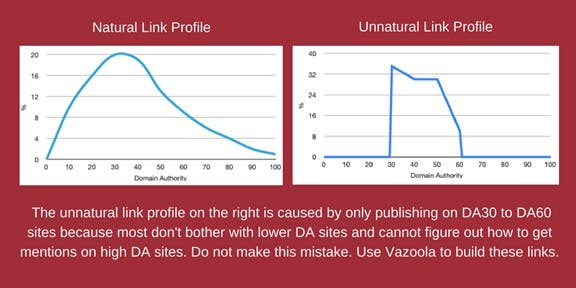
The reason this happens is that they do not want to pay to acquire more links that are under DA30 and they don’t know how to get mentioned on the most significant sites.
It is a mistake to only end up with links pointing from sites with mid-range DAs. Vazoola is perfect to help you with both higher and lower end sites.
Another common SEO mistake is to only build links to money pages. As mentioned previously, we recommend building links to your home page and strongest content.

Another common mistake is getting backlinks from low quality sites that will not help your rankings. As we mentioned before, links with low authority, no traffic, or in a niche not in any way relevant to yours are much less likely to be helpful to your rankings.
Also be aware of backlinks that are considered outright spammy. Backlinks from Public Blog Networks (PBNs) or link farms are to be avoided at all costs. A public blog network is a group of blogs owned by the same person or entity that all link to each other, often share the same or similar IP addresses, and are designed unnaturally boost the rankings or domain authority of each other and the websites they sell links to.

Link farms are a similar thing, but on an individual level. It is a website that exists solely to sell backlinks. They typically post low quality content, do not rank for any keywords, and do not get real search engine traffic.
Both of these link schemes are easily detected and devalued by Google, so you should save your time energy and resources by avoiding these links.
7.2 Black Hat Tactics
Engaging in black hat tactics for link building is a significant mistake that can result in severe penalties from search engines. These unethical practices manipulate search engine algorithms to gain higher rankings through deceitful means.
Examples of black hat tactics include keyword stuffing, cloaking, and using hidden text or links. The following methods violate Google's guidelines and lead to a loss of trust and credibility with your audience:
-
Keyword Stuffing: Keyword stuffing involves overloading a webpage with keywords in an attempt to manipulate a site's ranking. It can make your content unreadable and off-putting to users. Instead, use keywords naturally and contextually within high-quality content.
-
Cloaking: Cloaking shows one version of a webpage to search engines and another to users. It's a deceptive practice that can lead to severe penalties. Always make sure what you present to search engines is the same as what users see.
-
Hidden Text or Links: Hiding text or links by making them the same color as the background, using tiny fonts, or positioning them off-screen is considered black hat. These practices are easily detected by search engines and can result in significant penalties.
To avoid black hat tactics, focus on white hat SEO strategies. Create valuable, high-quality content that naturally attracts backlinks. While you're at it, try engaging in ethical link-building practices like guest blogging, influencer outreach, and earning links through content marketing.
7.3 Low Quality Links and Websites
Obtaining backlinks from low-quality websites can be detrimental to your SEO efforts. Links from sites with low domain authority, poor content quality, and no real traffic offer little-to-no value and may even harm your rankings. Links from websites that are not relevant to your niche also can be flagged as spam by search engines.
When evaluating possible backlink opportunities, evaluate the linking website based on the following criteria:
-
Assess Site Quality: Before pursuing a backlink from a site, evaluate its domain authority, content quality, and relevance to your niche. Tools like Moz's Domain Authority and Ahrefs' Site Explorer can help you assess the quality of potential link sources.
-
Prioritize Relevance: Make sure the sites you are targeting for backlinks are relevant to your industry. Links from niche-relevant websites are more valuable and credible. For example, a backlink from a respected industry blog or trade publication can significantly boost your site's authority.
-
Avoid Link Schemes: Steer clear of link schemes like buying links from low-quality directories or participating in link exchanges with unrelated sites. Such practices violate Google's guidelines and can result in penalties.
-
Focus on Content Quality: High-quality content naturally attracts backlinks. Invest time and resources into creating informative, engaging, and valuable content that others will want to link to. This might include blog posts, infographics, case studies, and original research.
-
Regular Link Audits: Conduct regular audits of your backlink profile to identify and disavow low-quality links. Tools like Google Search Console, Vazoola's Free Backlink Checker, and other third-party SEO tools can help you monitor and manage your backlinks effectively.
By focusing on acquiring high-quality, relevant backlinks and avoiding unethical practices, you can build an effective link-building strategy that enhances your site's SEO performance.
8. Monitoring Your Backlink Profile
Whether you are actively building more backlinks or hope to earn more links organically, it is essential to monitor your backlink profile.
Incoming links should be a mix of types of anchor text and also sources. Too many so-called SEOs with little knowledge will focus on links that are auto-approved.
They end up with backlink profiles so unnatural they can trip an algorithm or get your site penalized.
For example, while links in comments are easy to get, they are low value and typically nofollowed. Too many comment or forum links can be dangerous when you do not have other types of links to balance them out.
8.1 Negative SEO
Monitor your backlinks to detect negative SEO so you can work on recovery quickly. Waiting until your income drops dramatically can be costly.
While Google claims it can detect negative SEO so that it will not affect your site, some have fallen victim to it.
Even in 2023, negative SEO is still happening. According to Neil Patel, negative SEO definitely exists. He offers tips on how to protect your site from negative SEO here.
Reverbico covers these types of negative SEO attacks:

8.2 Google Advice on Viewing Incoming Links
Both Matt Cutts and John Mueller have publicly stated that using the link:URL command should not be used to find incoming links.
Google advises using the “Links to Your Site” report found under the Search Traffic category in the Google Search Console.
9. What are the Risks of Link Building?
There are a few risks to be aware of when it comes to link building. Careful thought and strategy should be used when building your own backlinks.
Chief among these risks is avoiding all black hat tactics. The other biggie is not wasting resources on low quality links that don't impact rankings. After all, Google discredits low-quality links.
To alive potential penalties - and wasted resources - avoid low quality link. Employing professional help can mitigate the risks since expert SEOs understand Google guidelines and best practices.
9.1 Recovering From Penalties
The first signs your site may be penalized (or have a technical problem) will be dropping traffic and/or lost sales.
Immediately check your analytics to see if your traffic has dropped off. If it has, drill down to determine what incoming sources of traffic are lower than usual.
When organic traffic drops, and in particular from your organic Google search results, you need to find out why.
Immediately log into Google Search Console to get additional information. [Note that search console was formerly known as Google Webmaster Tools.]
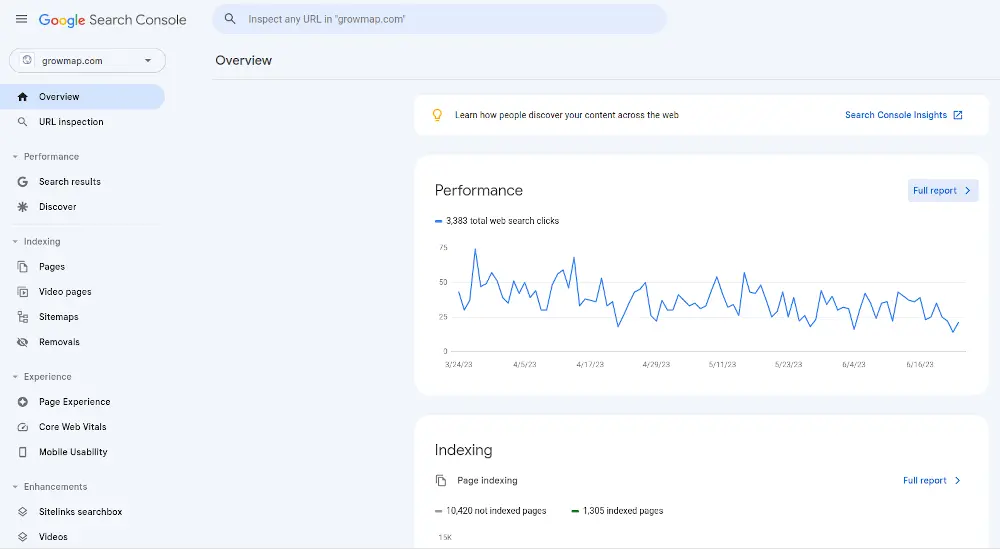
Every site owner needs to have access to this free tool and information. Bruce Clay has provided instructions on How to Set Up Google Search Console.
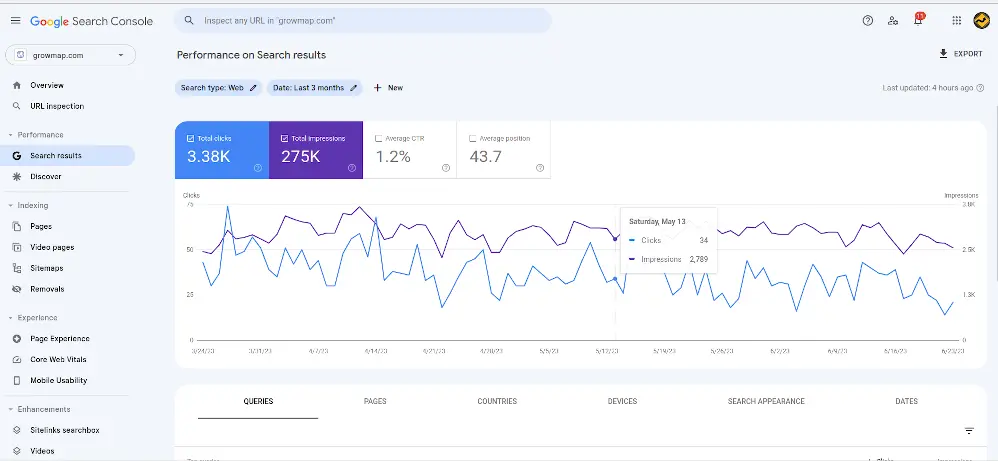
Go to Security and Manual Actions (left navigation) > Manual Actions section and check for manual penalties. There will be information online on how to recover from each type.
What you hope to see is "No Issues Detected".
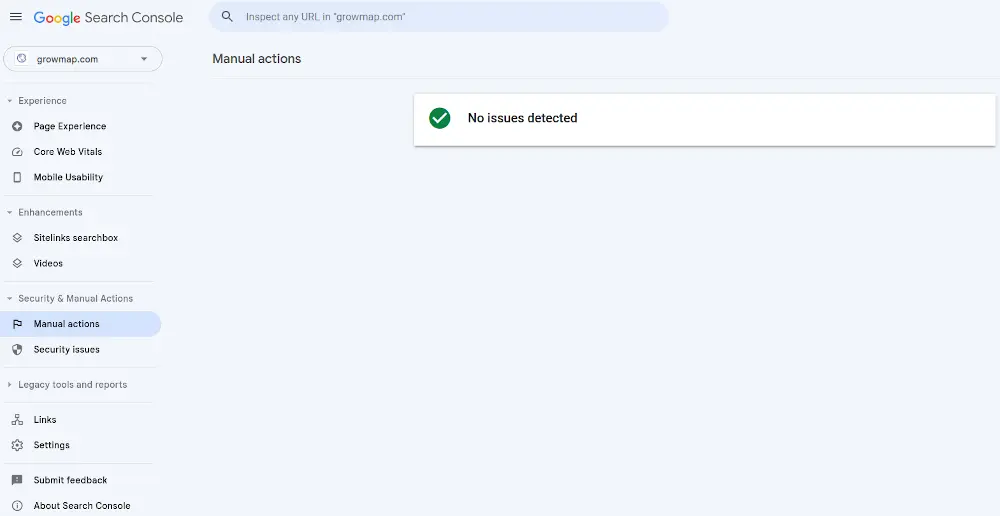
You could start with 9 reasons your rankings suddenly dropped: recovery guide.
9.2 Manual Penalties
"The only true penalty, according to Google, is what’s known as a manual action.
This means that a human reviewer has looked over your website and issued a penalty for violating some aspect of the Webmaster Quality Guidelines."
You should receive an email and be able to see any manual action against your site in your Google Search Console.
Other issues are caused by algorithms and are not considered penalties (although many still call them penalties).
9.3 Unnatural Inbound Links
An unnatural inbound link penalty is a manual penalty Google levies against a site they believe built incoming links. Negative SEO may also cause this penalty.
Search Engine Journal provides comprehensive information about Google penalties, manual actions and notifications including how to recover.
9.4 Unnatural Outbound Links
The most straightforward penalty to fix is the manual unnatural outbound links because they are all on your site.
What most do to recover is to remove or nofollow their outbound links.
9.5 Algorithmic Penalties
Algorithms were infrequently updated in the past. If you were penalized by one, you had to wait for the next update to see if your site recovered.
Today, they are “live” and immediately update. Live updates allow you to recover more quickly, but also be penalized much faster.
Immediate updates could make it easier to connect something you did with why you were penalized. Google algorithmic penalties can be applied at the page level rather than across the entire site.
9.6 Panda Penalty
The Panda algorithm was a filter intended to weed out poor quality and thin content. It is not considered a penalty, but many still refer to it as one.
Hyung-Jin Kim, the VP of Google Search, told SEL that Panda was replaced by Coati which is now part of the core ranking algorithm.
9.7 Penguin Penalty
First introduced in April 2012, the Penguin algorithm was also not considered a penalty, but is widely referred to as one.
Penguin was rolled into the core ranking algorithm in 2016.
9.8 Mobile First Index and Mobile Friendly Ranking Factor
Google now uses a mobile first method of indexing websites. If your site is not mobile friendly, that has a negative impact on your potential traffic.
You can test your website using this mobile-first index tool.
10. Link Building Tools
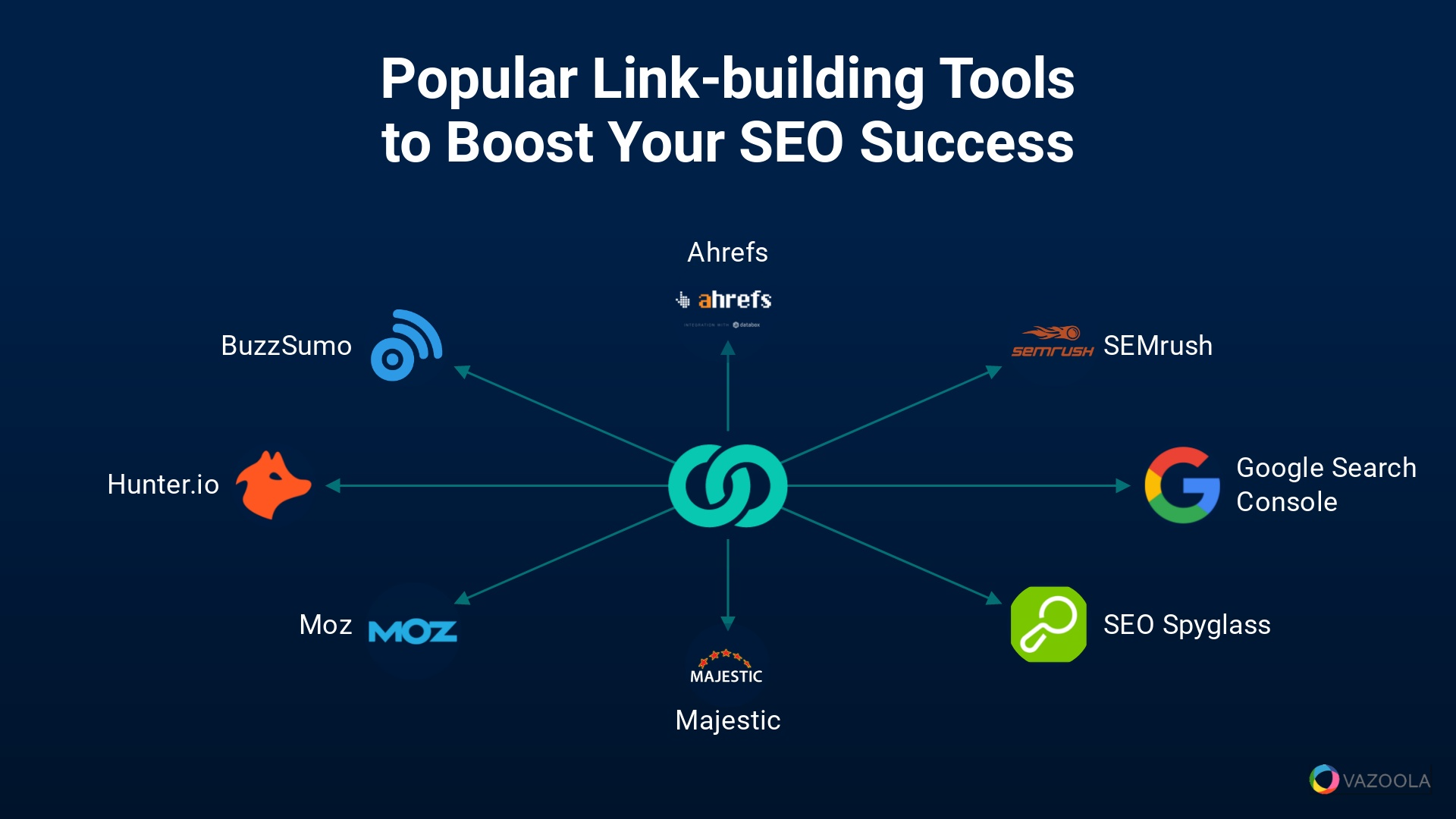
There are so many link building tools that we have a separate tools guide to explain them. Here are the main types of link building tools:
10.1 Backlink Research Tools
Backlink research tools help you analyze your backlink profile alongside that of your competitors. The tools provide insights into the quality, quantity, and sources of backlinks, and they help you identify opportunities and improve your link-building strategy. Backlink research tools include:
-
Ahrefs: Ahrefs is a powerful tool that provides comprehensive backlink analysis, allowing you to see who links to your site and your competitors. It also offers insights into keyword rankings, content gaps, and overall SEO performance.
-
SEM Rush: SEMrush offers detailed backlink analytics, helping you monitor your backlinks and compare them with competitors. The tool also provides tools for keyword research, site audits, and traffic analysis.
10.2 Monitoring Tools
Monitoring tools keep track of your backlinks and alert you to any changes. They help you maintain a healthy backlink profile by identifying lost or broken links and ensuring your links remain active and valuable.
-
Monitor Backlinks: Monitor Backlinks tracks your backlink profile, notifying you of new, lost, or broken links. It helps you maintain a strong backlink profile by providing insights into link quality and potential issues.
-
Link Research Tools: Link Research Tools offers a suite of tools for backlink analysis and monitoring. It helps you identify risky links, analyze link quality, and ensure your backlink profile is optimized for SEO.
10.3 Outreach Tools
Outreach tools streamline the process of contacting potential link sources. These tools help you manage your outreach campaigns, track responses, and build relationships with influencers and webmasters.
-
Pitchbox: Pitchbox is an outreach platform designed for link building and influencer marketing. It automates the outreach process, allowing you to manage campaigns, track responses, and follow up with potential link sources efficiently.
-
HARO (Help a Reporter Out): HARO, now known as Connectively, connects journalists with sources. By providing expert insights and quotes, you can earn high-quality backlinks from reputable media outlets.
10.4 Citation Management Tools
Citation management tools help you manage and optimize your business listings across various online directories. These tools ensure that your business information is consistent and accurate, improving local SEO and online visibility.
-
Bright Local: Bright Local is a citation management tool that helps you monitor and manage your business listings across various directories. It ensures your business information is consistent and accurate, boosting local search rankings.
-
Moz Local: Moz Local helps you manage your business listings, ensuring consistency across online directories. It improves local SEO by identifying and fixing inconsistencies in your business information.
Using these link-building tools can enhance your SEO strategy, making it easier to analyze, monitor, and improve your backlink profile.
11. Common Link Building Strategies
Building a robust backlink profile is an absolute must for improving a website's search engine ranking. There are three primary ways to acquire links: earning them, building them, or buying them.
Each link-building strategy has its unique approach and benefits. Keep reading as we explore these methods and discuss other common link-building techniques that are fast, effectively controlled and predictable.
11.1 Earn Links
Earning links is the most natural link-building method, and it aligns with Google's guidelines. Earned links come from creating high-quality, valuable content that others find worth linking to.
11.2 Build Links
Building links occurs when you actively seek out and obtain backlinks from specific sites. The method offers more control over links' origins, and it can target high-authority sites relevant to your niche.
11.3 Buy Links
Buying links can be a quick and effective way to build backlinks. The method provides predictability and control, but because it skirts Google's guidelines, it requires careful selection to avoid penalties from search engines.
11.4 More Specific Common Link Building Strategies for SEO
While all links are either earned, built or bought, each category is made up of more specific link-building strategies, including:
-
Leverage Public Relations (Earn): PR involves engaging with the media and creating newsworthy content that attracts attention and links from reputable websites.
-
Engage in Industry Forums and Communities (Earn): Participating in discussions and contributing valuable insights can earn you links from forum members.
-
Utilize Social Media (Earn): Sharing your content on social media platforms can attract links from users who find your content valuable.
-
Earn Links Through Networking (Earn): Building relationships with other industry professionals can lead to natural link opportunities.
-
Conduct Original Research and Studies (Earn): Publishing unique research and studies can attract backlinks from websites that reference your data.
-
Content Marketing (Earn): Creating and promoting high-quality content can naturally earn links.
-
Original Research (Earn): Conducting and publishing unique studies can attract links from sites referencing your work.
-
Email Outreach (Earn): Reaching out to relevant websites and bloggers to share your content and request backlinks can be effective.
-
Directory Submissions (Build): Submitting your site to reputable directories helps gain backlinks.
-
Broken Link Building (Build): Finding broken links on other websites and offering your content as a replacement is another useful strategy.
-
Skyscraper Technique (Build): Creating content that is better than existing top-ranking articles and reaching out to sites linking to them can generate backlinks.
-
Competitor Backlink Analysis (Build): Analyzing your competitors' backlinks and targeting the same sites for your links is a strategic approach.
-
Testimonials and Reviews (Build): Providing testimonials and reviews for products or services in exchange for a backlink is a common practice.
-
Local Citations (Build): Listing your business in local online directories can gain backlinks and improve local SEO.
-
Link Exchange (Build): Exchanging links with other websites in a mutually beneficial arrangement can be effective.
-
Sponsored Posts (Buy): Paying for a post on another website that includes a link to your site is a quick way to build backlinks.
-
Paid Directories (Buy): Paying for listings in high-quality directories that provide backlinks is another great option.
12. On-Page SEO
There is more to SEO than link-building. Ensuring you have your pages optimized first is just as important.
Find out everything you need to know in Moz’ On-page SEO Guide.
13. Content as an SEO Strategy
As Google’s algorithms have improved, SEOs like Martin MacDonald have said:
"It became easier to just build the best for the query rather than trying to find ever more elaborate linking schemes”.
He works in highly competitive niches, currently travel and previously casinos. He says:
“It’s time to invest in content, and being the “right answer” to queries, not focusing on eeking out % of ranking factors”.
13.1 Quality Content Defined
Before you build any links you need exceptional content. Even if you ask someone for a link, you cannot have one just because you want one.
There need to be resource links of value on your site to link to from their content. The most advanced link building tips won't help if your content is weak.
Other websites link to great content. To earn links you haven’t explicitly requested and to actively build links, endeavor to publish the best possible content on your chosen keyword phrase.
It should be lengthy and comprehensive. 700+ words are the absolute minimum, and at least twice that is more common.
As of 2022, Neil Patel's research recommends pillar content of "2501-3000 words generated by far the most traffic".
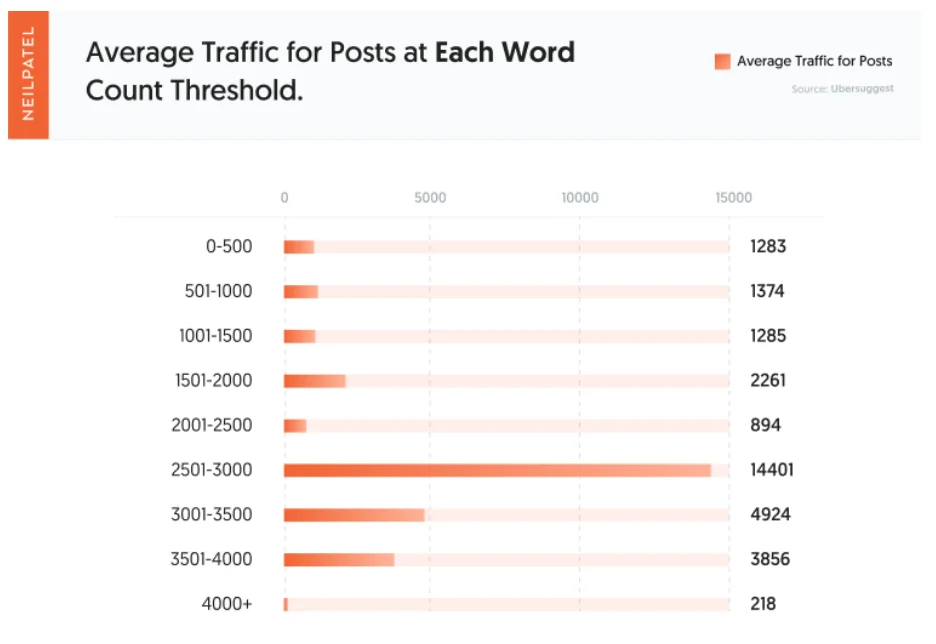
That is also a word range that attracts the most links (along with 1000-2000 words).
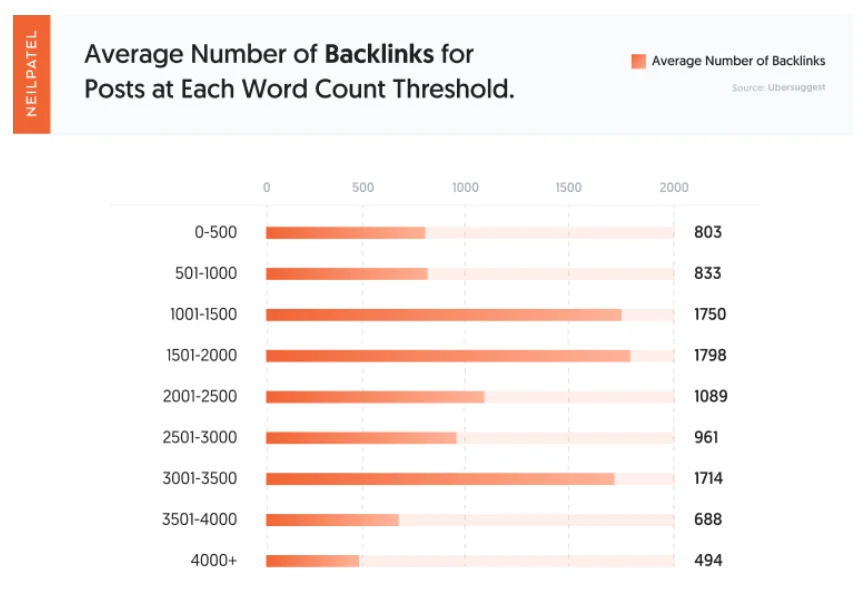
Other terms commonly used for pillar content are flagship content and cornerstone content. The SEO plugin Yoast provides a cornerstone content strategy.
The best way to get journalists and influencers to link to your content is to include current statistics they can quote.
If your content includes multiple statistics, they may even suggest their readers click through to see more. Your goal is to get your link embedded in the text of their content.
Every major keyword phrase you plan to target needs a separate post or page on your site. Then incoming links on that keyword phrase should always be linked to that specific URL.
Short on time to create content yourself? Get introduced to influential content writers by using Vazoola.
13.2 How to Create Quality Content
The easiest way to get ideas about what to write is by researching the top content for the keyword phrase you plan to target.
You can find this content using Google, any search engine, or BuzzSumo. BuzzSumo allows a very limited number of daily searches from their free version.
Serious writers typically use the Pro version which allows unlimited searches and provides additional features.
Review the best content about your keyword phrase. Make notes and add additional ideas as they come to you.
If you set up a Trello board for your keyword research, you can do this on the card for that keyword phrase.
Do use these notes and ideas to write the most comprehensive content possible on your topic. But be careful not to plagiarize.
Only original content will rank. And it is not good for a company’s reputation to be accused of stealing content from others.
When you’re ready for advanced strategies, check into Brian Dean’s Skyscraper Technique.
13.3 Add Compelling Media to Increase Views, Shares, and Links
Content that contains images, videos, SlideShares, infographics, graphs, and current statistics gets shared more on social sites and attracts more readers.
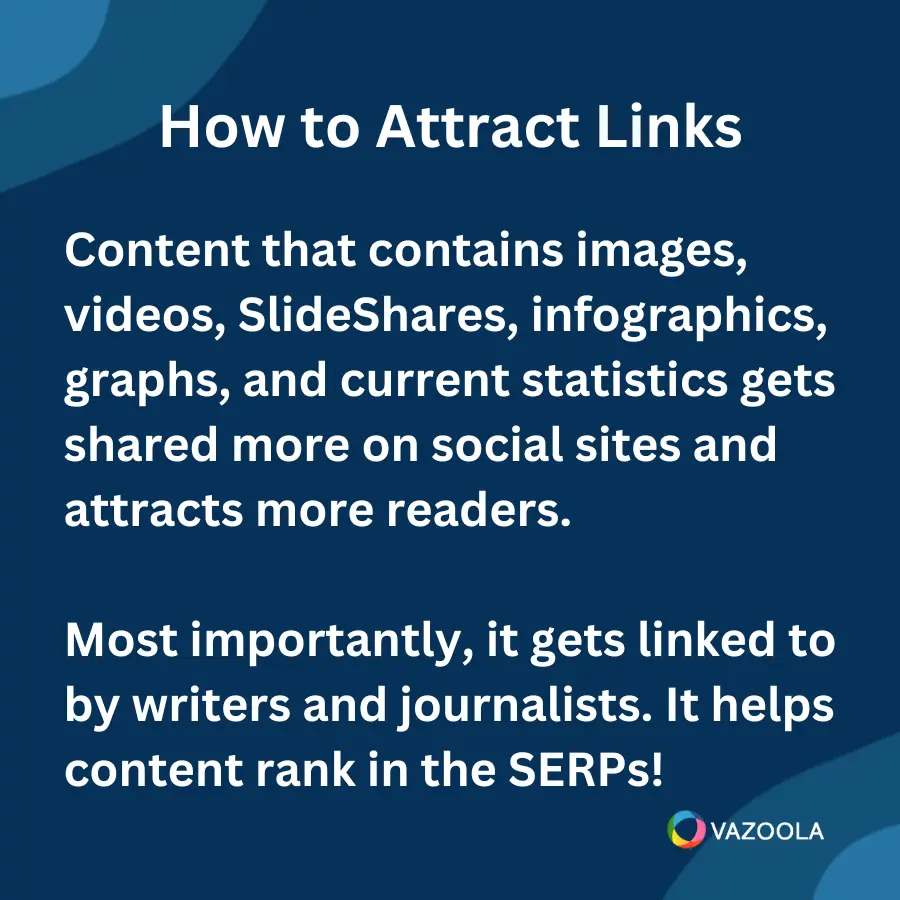
When journalists and writers are deciding which supporting documentation to link in their articles, they choose the most comprehensive and visually appealing content.
13.4 You Get What You Pay For
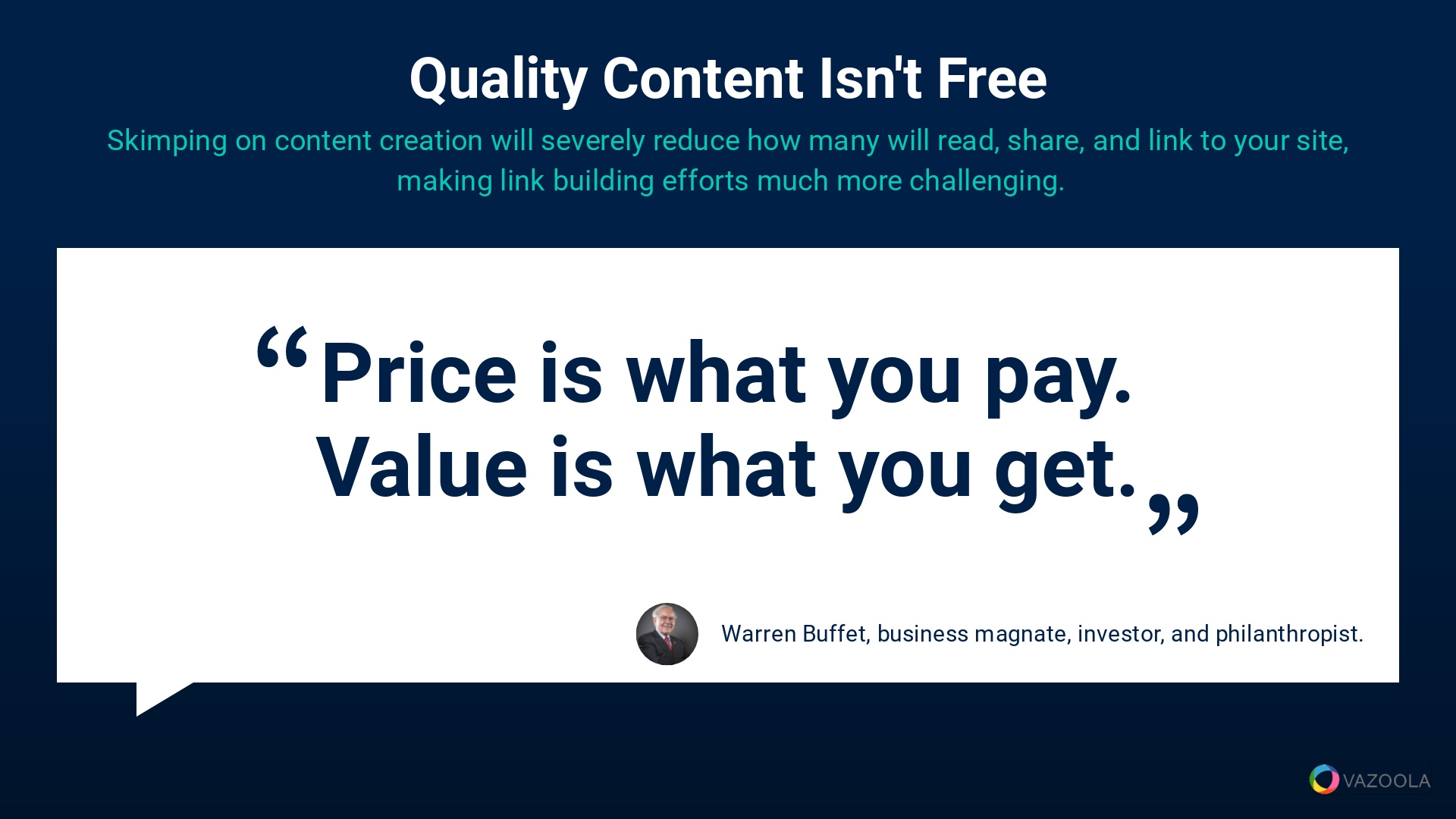
Skimping on content creation will severely reduce how many will read, share, and link to your site. It will make link building efforts much more challenging.
The significant difference between cheap content and using an influential writer is accuracy. Any writer can research, read, and regurgitate what they found into a new article.
But if they are not subject matter experts on the topic, they may have no idea what is correct and what is not. What they write can only be as accurate as the sources they found.
If you are an expert in your field, consider providing the sources you wish the writer to use. Also be sure to review their content for accuracy.
13.5 Plagiarism Checkers
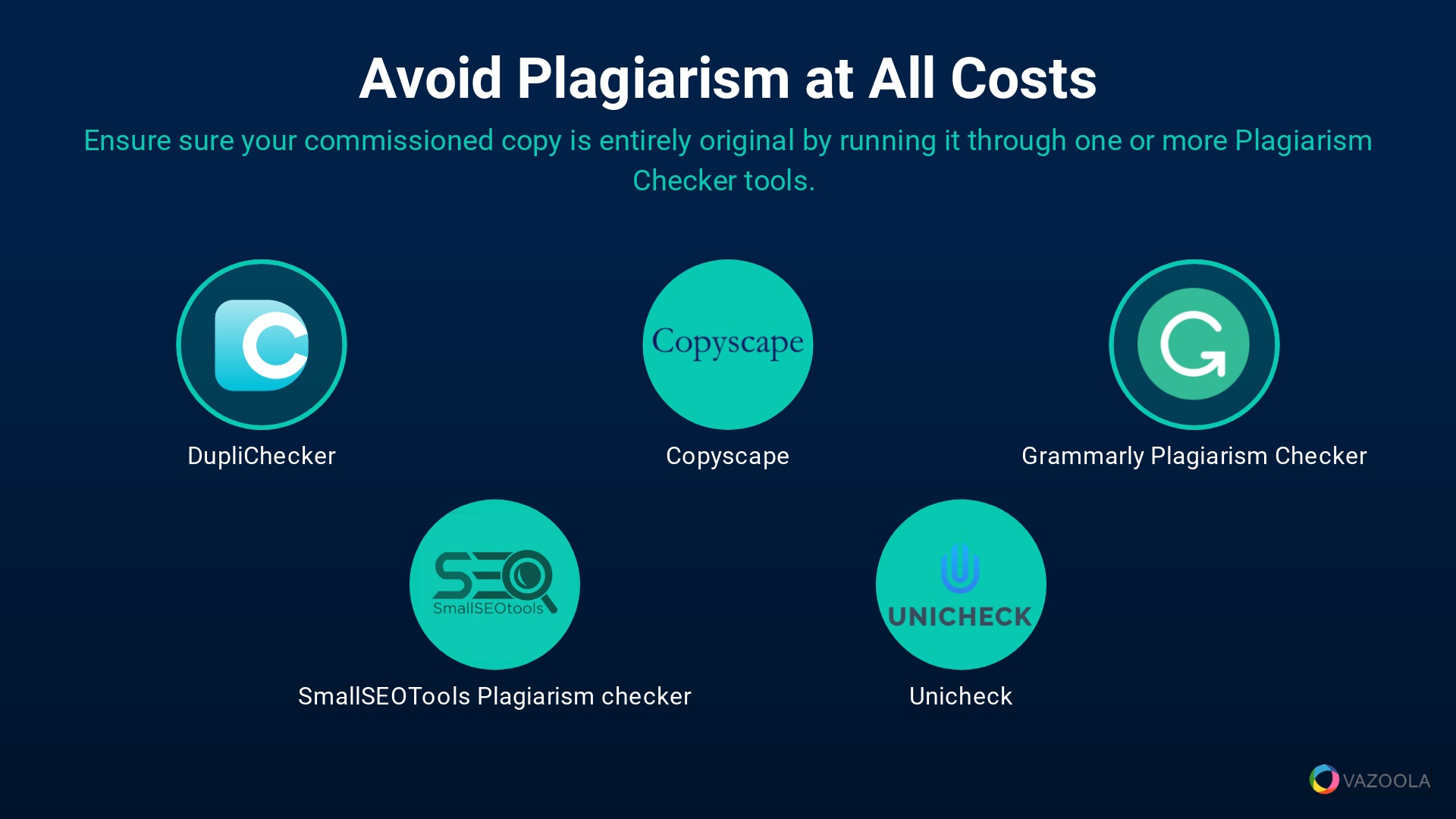
Commonly recommended solutions that provide plagiarism checking include:
Some of these are web-based with add-ons for specific browsers and solutions. Others you can download to your desktop.
When using ghostwriters, you will want to run their content through at least one plagiarism checker.
14. SEO Case Studies
Getting SEO right can lead to more than just traffic and direct sales. Here are some exciting success stories:
14.1 Finance Company Sees 654% Traffic Increase Due to 4 #1 Keywords
One of our finance company clients had a goal of moving their five most important keywords to the top of the SERPs. We achieved that goal, hitting #1 for four of them and #3 for the fifth!
The traffic on these five keywords increased from approximately 46k to 347k, an increase of almost 654% (see graph below):
Monthly Search Volume Table Based On Ranking Positions of 5 Keywords
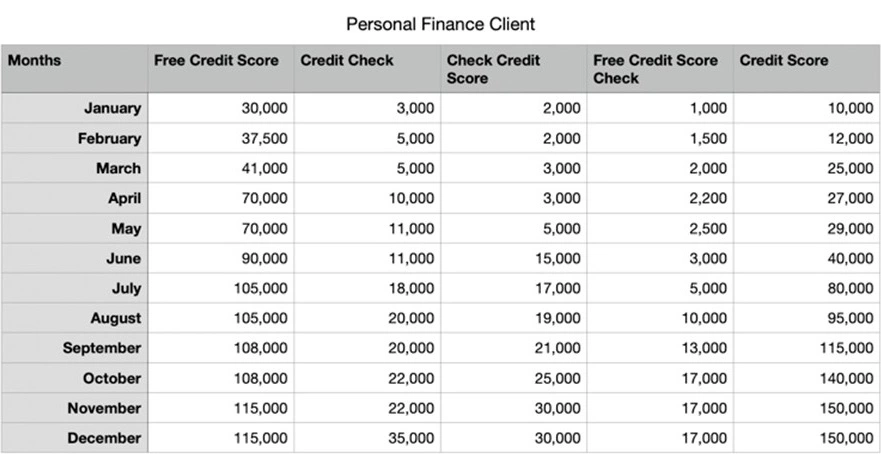
Want to know how we did it? Read the full case study here.
14.2 Salt Lake City SEO Agency Reduced Link Spend from $144,000 to $90,000
This agency increased their profit margin on links by using Vazoola's Bounty Express. They were able to obtain DA30+ links of equal or higher quality every month for all of their clients.
Their client manager workloads dropped due to our more advanced platform. And their clients' rankings quickly started climbing.
Read the full case study here. There is no reason your company or agency could not be doing just as well.
15. When Should I Start Link Building?
Project Manager Josh McCormack summed SEO and content up well:
“Life, and SEO, are not a meritocracy. Great content will not rise to the top by itself. It needs to be optimized, promoted and connected. In short, the best answers might be on the 100th page.”
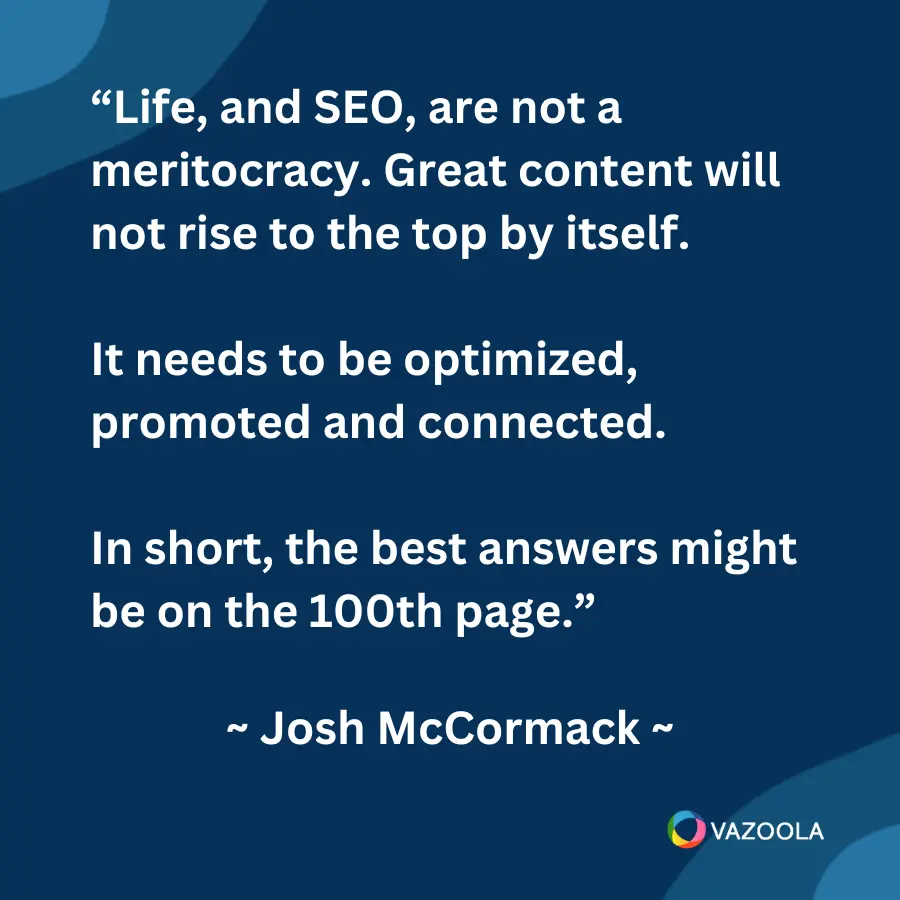
If you don’t want your exceptional content to stay on the 100th page, you need to take action. The sooner you get started, the faster your site and business can grow.
The best time to start link building is after you have taken care of technical SEO and on-page SEO. We'll explain why. There are many technical issues that can prevent your website from ranking well or at all, and these need to be addressed first.
For example, if you site is not indexed with Google, or a page has a NoIndex tag, no matter how many links you build your site will not rank.
Next, you should do keyword research to create a strategy around how to optimize your pages. This is important for two reasons.
-
If you have not yet done your keyword research you will not yet know what anchor texts are optimal for your link building strategy.
-
If you don't optimize your page for your target keyword, it won't be competitive in the rankings no matter how good its backlink profile is.
16. The Benefit of Working with an Agency
Its no secret that link building is a lot of work. To do it right it has to be as we have shown in this comprehensive guide. Many business owners, marketers, and SEOs decide that they don't have the bandwidth to build links for themselves.
Partnering with a link building agency makes link building accessible to everyone. When you work with a reputable company your ROI on link building will go through the roof.

It's difficult to compete with the attributes of a link building company such as size, scale, expertise, and relationships. These are all critical aspects of link building efficiently. You will also benefit from more nuanced strategies, expert level SEO tools, campaign flexibility and real time feedback.
17. How Do Link Building Services Work?
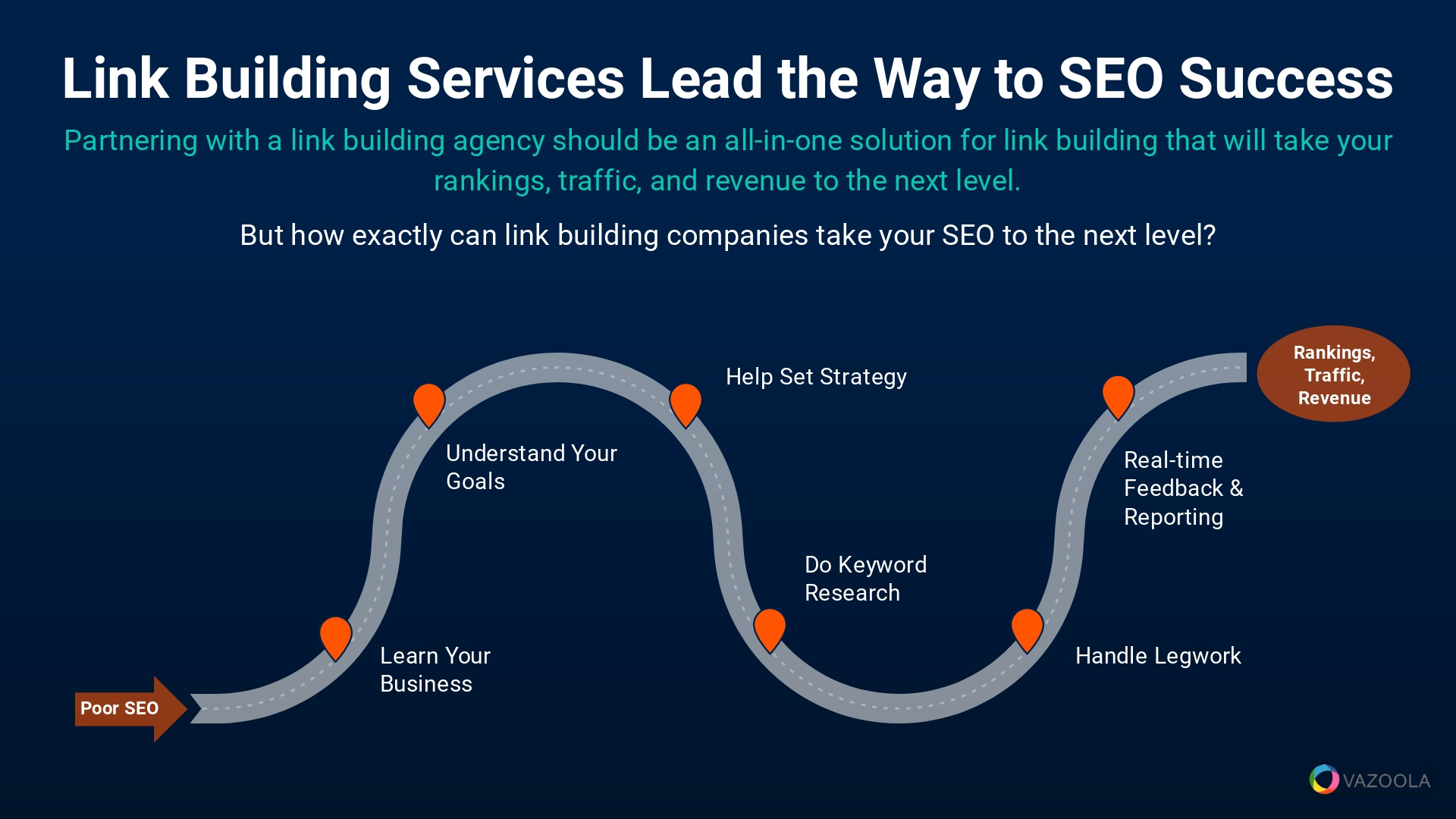
A good link-building service acts as a true partner in your digital success, and it all starts with a deep understanding of your business and goals. They align their efforts with your specific objectives, whether it's increasing traffic, boosting sales, or enhancing brand visibility. Their tailored approach starts with in-depth keyword research so the links they build drive the right kind of traffic to your site.
A good link-building service will:
-
Learn your business: Understand your industry, target audience, and unique value propositions.
-
Understand your goals: Align efforts with specific objectives like increasing traffic or boosting sales.
-
Help set strategy: Develop a clear, achievable plan tailored to your needs.
-
Do keyword research: Identify the most relevant and high-impact keywords for your industry.
-
Handle the legwork: Manage everything from identifying link opportunities to reaching out to potential partners.
-
Provide real-time feedback and reporting: Keep you informed and allow for strategic adjustments.
-
Adjust the strategy as needed: Use expertise to refine the approach based on results.
-
Shield you from the risks of negative SEO: Protect your site from harmful backlinks and unethical practices.
Partnering with a reputable link-building service also protects you from the risks of negative SEO. With their size, scale, experience, and sophisticated tactics, link builders safeguard your site from harmful backlinks and unethical practices.
An all-in-one solution makes link building painless while elevating your rankings, traffic, and revenue. By leveraging professional expertise, you can focus on running your business while they enhance your online visibility and drive your success.

